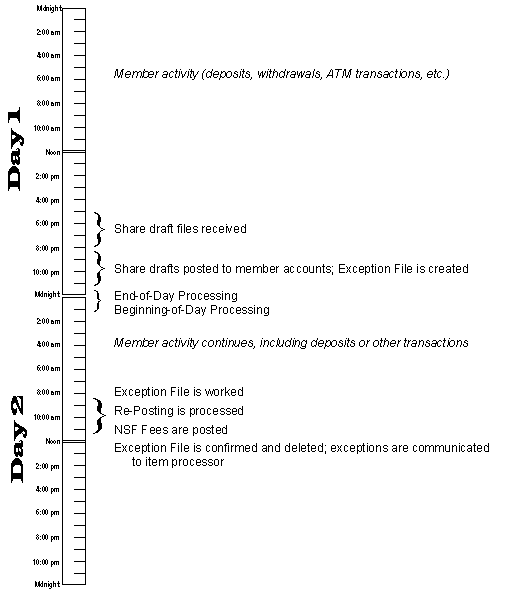Member Check Processing
In the history of the credit union industry, nothing has provided the power to compete with other financial service organizations like the move toward credit union member share draft/checking accounts. This enabled credit unions to become primary financial organizations for their members. Day-to-day banking with credit unions became a reality. What was once a savings and occasional loan industry became a real alternative to banks and other financial institutions.
CBX has several sophisticated and cost-effective tools for handling member share draft/checking accounts. While this discussion deals with the handling of exceptions, it is important that as a credit union professional you understand the entire share draft/checking program to better understand how the system flows and works with your credit union.
Key areas to consider:
· Dividend Application Configuration
· NSF and Overdraft Policy Configuration
· Service Charge Configuration
· Relationship Management
· NSF History Tracking
· Re-Posting - Fees and Services
· Accounting - Tracking a Third-Party Vendor
· Automated Non-Returns (ANR) or “Courtesy Pay” programs
This section describes using the CBX Member Check Processing tools to handle exceptions. If the credit union utilizes all of the tools available in the core it will be able to make the following key claims:
· No check is returned without current available balance consideration right up to the point of cutoff.
· NSF items where funds are available by cutoff will be covered by the credit union and save the member the embarrassment of returned items. Automated non-returns, if configured, allow members to post to a negative balance up to a CU-defined limit.
· All processing is automated and consistent without bias.
CBX lets your institution be a specialist in the delivery of checking account services. Call today to see if we can improve your products.
Overview: Working With Exceptions
The CU*BASE Member Check Processing tools are used to work with the check/draft Exception File. Each night, your item processor presents a batch of member checks to be posted to your member accounts.
The Exception File includes drafts that were presented but could not be posted for a variety of reasons, including non-sufficient funds, invalid account, stop payment, frozen account, etc. Your credit union must then provide instructions to your item processor on how these items should be handled. They can be returned, force paid, or held for later action.
You may also instruct the system to post the items to member accounts again. Deposits will often be made in the morning to member accounts via mail posting, ACH, payroll or member visits. Re-posting may allow many of the exception items to clear, saving your members from the embarrassment of a returned check.
A Daily Timeline
The following illustrates the typical chain of events in share draft/checking processing. The times are approximate and may vary depending on your item processor and other factors.

SEE ALSO: Using Smart Operator to Verify Daily Share Draft Transmissions
Procedure: Working With Exceptions
Following are the steps required to handle the exception file each day. Generally, your item processor will have a cutoff deadline by which this entire process must be completed.
1.View or print the daily draft exceptions report (LNDET) and research any items with return codes other than 31 (NSF), such as invalid accounts. As needed, view check images and perform account inquiries to determine what should be done with the exception.
2.Use Work Member Exception File feature to view the complete exception file. Make any modifications or additions to the list, such as modifying an account number or the return status instructions.
3.Use the Re-Post Exception File Detail feature to post the entire exception list again. All items which can post will do so and the remaining items will remain on the exception list.
· Often, if deposits have been made though night deposits, ACH, payroll or member visits, it is possible that many drafts will actually clear. This can result in a smaller number of exception items. You may use the re-post option as many times as desired.
4.Repeat Steps 2-3 if desired to make additional changes or repeat the posting process.
5.Use the Post NSF Fees feature to post any returned item fees to member accounts and generate NSF notices.
· After this step, you will no longer be able to work the exception file except to view it.
6.Use the Confirm/Transmit Member Returns feature to confirm the exception file and clear it in preparation for the next day. Depending on your third-party vendor, the file may also be transmitted to your item processor for return processing.
Third-Party Vendor Issues
CBX is designed to work effectively with the credit union's choice for third-part vendor solutions, for processes such as ATM, ACH, or share draft/check processing. Depending on the vendor's ability to communicate, report, and interact with the core software, your procedures may vary from the processes outlined in this manual. It is important for you as the credit union data processing coordinator to understand the nuances of working with each chosen vendor.
· Remember that CU*Answers is always available to counsel, customize, or develop new ideas based upon the vendors that you choose. Communication is the key to a successful partnership between you, your third party vendor, and CU*Answers—as well as the time required to make sure that your programs meet your requirements. If you are considering a change, contact your CU*Answers representative as early as possible. Programming charges may apply.